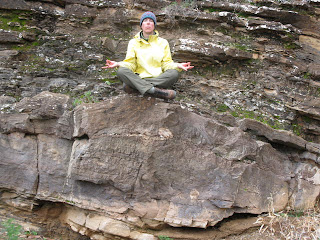So there are a series of rock formations that Catherine and I are looking at. Noted from the oldest to youngest.
Balcanoona (aka Etina) - Is a carbonate layer. These are rocks made out of calcium carbonate, and therefore will bubble when in contact with acid. In order for carbonate to form, there needs to be a relatively shallow, warm water sea that interacts with the atmosphere.
Trezona - This is also a carbonate layer; however, often it is interbedded with siltstones which are formed in a deeper ocean environment. This formation has a variety of exciting features. There are ripples as well as stromatolites. Stromatolites are a primitive life form that are believed to be one of Earth's earliest life forms. Currently, stromatolites are only found in extreme locations such as Buzzard's Bay in Australia which has a very high salinity. Stromatolites are formed by layers of algae mats and sediment. The algae creates a sticky surface which sediment will adhere to. As the layers of sediment and algae build on one another, mushroom like structures will form. The stromatolites that I saw preserved in the Trezona varied in size from those smaller than my thumb to as large as a mini fridge. As you walk over these seemingly insignificant rocks, it is fun to imagine what Earth must have been like at the time that these stromatolites dominated our seas.
 |
| Stromatolite - note coin for scale |
 |
| Note coin on right hand side of the stromatolite |
 |
| Meditating on top of a massive stromatolite - meditator for scale |
In between, the the stromatolite mounds, there are other interesting structures to be found. Adam, Catherine, and the other Princeton colleagues noticed repeating shapes in the Trezona formation. They found three repeating shape stuctures. There were ones shaped like an H, a Y, and rectangles with either two or three spots in them. After analyzing the different pieces of debris found in between the stromatolites, it has been proposed that these shapes represent different perspectives of a primitive sponge.
 |
| I am pointing to the structure with two circles in it |
Yaltipena - is a silt layer that has distinct feature specific to shallow water environments. There are many layers of this red siltstone filled with ripple marks and mud cracks. In some cases, the ripple marks will criss-cross one another creating a tic-tack-toe affect. This shows that water currents changed directions in the particular area. The mud-cracks formed in an environment where the sediments alternated with exposure to the air and covered by shallow water. Think about areas influenced by tides.
 |
| Cross-bedding - ripple marks preserved in profile |
 |
| Ripple marks (top left hand) Mud cracks (lower right hand) |
Elatina - is the diamictite previously described in the last blog. It is a formation created by glacial movements. The rock matrix tends to be red in color and dominated by clasts of all different sizes and lithology (type).
Nuccaleena - is a dolomite (carbonate that has been chemically altered). It is distinctive in its buttery color.



Exactly how old are these rock formations? Are they spread out from each other? Does the age of the formation matter to where its located?
ReplyDeleteThese rock formations are very interesting. You can see what things were like, or looked like, years ago. Without using a time machine. You can also find out what the land looked like when the rock was formed. I think that is so cool!
ReplyDeleteBrendan, the rocks range in age. They are all over 500 million years old. While you tend to find the layers in the same order, they are found throughout southern Australia. We would often have to hike several kilometers to move between the different layers. The age definitely matters on the location. The sequence older to younger will always be the same. You know that once you find the Trezona that you can then expect to find the Elatina and then the Nuccaleena. It becomes very predictable. If you do not see this pattern that becomes an interesting problem to try and resolve.
ReplyDeleteI find it cool that people can look at a rock and understand how they were formed!!! It was really cool to look at the pictures it helped me get a better scence of what you were talking about. Rocks are very interesting!!!
ReplyDeleteI think it's way cool that we can learn about places before we exisited by looking at rocks. The pictures are very nice and it gives you a better understanding of what you're readin about.
ReplyDeleteIt was interesting to learn that you can learn stuff about the place by looking at rocks. I would love to be able to try that some day and see what i figure out about the place. I think that we should do that in class one day and i bet my other class mates would love to also.
ReplyDelete